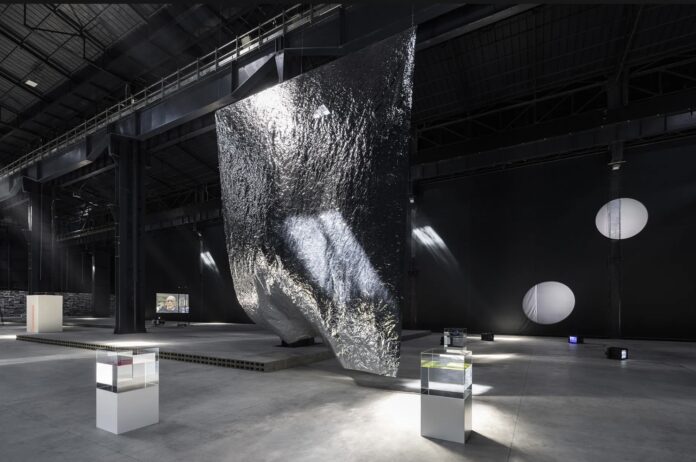Hangar Bicocca, spazio e non solo
Che bello fare l’artista! Che bello, con uno spazio a disposizione come l’Hangar, e non solo lo spazio, anche l’organizzazione, i soldi per fare quello che vuoi. Tutto è concepito in grande, si montano pareti, spazi chiusi, luminarie di tutti i tipi, schermi della dimensione che ti pare, getti di vapore, suoni; puoi salire a venti e passa metri d’altezza ad appendere le tue fantasie, come cospargere il pavimento di quanto ti pare.
Perfino Melotti, all’ingresso, il timido, il minuto, fantasioso scultore della delicatezza del filo d’ottone saldato, l’introduttore della musica nell’arte visiva, perfino lui all’Hangar s’abbandona al monumentale (le lunghe strisce di corten non stanno tutte ritte, tre o quattro son cadute in avanti. Ma non per caso: come cadute nell’erba curata del giardino, per permettere ai fari dell’illuminazione di avere il loro effetto – ma io mi permetto il sospetto: sarà veramente tutto suo o un suo disegno tradotto gigante ad usum delphini?)
Che bello fare l’artista all’Hangar! Ne esco arricchito?
Beh, niente di nuovo sotto il sole, sotto la sua eclissi, sotto il mare che riflette la luna, nella nebbia artificiale che impedisce lo spettacolo della partita di calcio allo stadio. Niente di nuovo sotto l’immensa parete stracarica, ma ordinatamente, di foto in BN della stessa dimensione: è la vita, amico! Sono la vita, la fila di macchine trascorrenti nella monotonia di un’autostrada, sono la vita i ciottoli arrotondati dal mare e sparsi sul pavimento.
Perfino il senso di grande solitudine degli spazi interstellari, la penetrazione telescopica nello sciame di stelle della Galassia, la luna attraversata dalle nostre nuvole; gli scherzi luminosi sugli schermi televisivi sono la vita. C’è del lavoro a mettere insieme tutto ciò con la perfezione e la pulizia che li fa godere tutti uno accanto all’altro, c’è grande professionalità: tanto di cappello, maestra!
Ripeto, niente di nuovo. Ma forse proprio perciò e per questa pulizia, questa purezza, bello, lontano dalla decomposizione e dalla merdanzia quotidiana che la vita odierna ci dispensa a iosa; se abbiamo un attimo per fermarci a contemplare, se la vita ci consente di “staccare”, di vincere l’ossessione di dover pensare alla pagnotta, alla cattiveria e furbizia umane, quando per un attimo ti è consentito di dimenticare la morte (è possibile?).
Ann Veronica Janssens all’Hangar, sensibilità visiva e raro equilibrio
Tutto molto pulito, perfino la putrella a terra, tutto lucido e naturalmente anche i vetri e gli specchi sparsi un po’ dovunque a riflettere il fascino buio dell’antica Pirelli. Che la signora abbia sensibilità visiva da vendere nessun dubbio, basta pensare al grande pannello tutto crespato, appeso in alto di fronte alle luci naturali laterali, alle cortine che la filtrano davanti agli ingressi sul giardino, ai piccoli prismi piazzati sui vetri: il gioco dimensionale fra il mastodontico e il cristallo è il pane di ogni opera che si rispetti e quelle di Ann Veronica si rispettano. Non c’è riempimento, non siamo sopraffatti, tutto è calibrato e studiato al millimetro, lo spazio non è ingombrato.
E’ molto oggi. A.V. riesce addirittura a superare certi effetti alla Turrell, a giocare col vuoto meglio anche del primo Kapoor; in un lavoro, uno dei migliori, si sente addirittura l’influenza di Beuys: in un grande schermo un vecchio (l’archistar Oscar Niemayer) fuma il toscanello in loop davanti alla sua biblioteca, è austero, meditativo (pensa alla morte? è probabile, è molto vecchio e se ne sbatte di tutto). Ma nessun plagio: l’insieme è autenticamente della Janssens, la sua misura, la sua pulizia, il suo equilibrio visivo sono rari.
Essenziale e pulita, una mostra spettacolare
Benissimo. E la novità, quella che ogni artista deve al suo pubblico? L’epoca è distratta, stupida, piena di sé e ignorante: va rieducata a guardare, a fermarsi di fronte all’immensità dell’universo; questa gli serve da lezione: la bestia più crudele e più intelligente della terra forse cala la cresta. E’ molto, d’accordo, e giustifica la ricchezza degli spazi e dei mezzi messi a disposizione: una delle mostre più pulite e spettacolari dell’Hangar. Onore al merito.
Ma l’hangar?
Il suono delle vecchie presse dell’antica officina, il rumore dei carroponti, delle fiamme ossidriche, dei carrelli trasportatori dei panni intimi di tutti accumulati da Boltanski non molti anni fa? Dove sono finiti nel buio dei capannoni mascherati da una pittura impeccabile? Dove il lavoro, dove le tracce dello sporco, della morchia sulle mani che il lavoro ci procura tutti i sacrosanti giorni? Dove è finita la memoria? In contrappunto le torri di Kiefer ondeggiavano precarie e nell’aria delle immense capriate d’acciaio i semi aerei dei pioppi erano penetrati a ricordare la natura della polluzione spermatica, vegetale, filoanemonica, leggera, casuale, imprevista, bianca, luminosa.
Vado a cercarla fuori. Ma prima dell’uscita sono passato in una stanzetta 2×2: un’unica piccola foto di un bosco con accanto, dentro una cornice semplice semplice, uno sgorbio a matita, neanche un punto interrogativo. Bellissimo, autentico: la poesia è passata di lì. Ho trasalito, il suo brivido mi ha scosso: l’arte non ha bisogno di grandi spazi, di teatri dello spettacolo, deve essere anche negli angoli più insignificanti e miserabili: è frutto di un attimo, non ti appartiene, non appartiene a nessuno.
L’arte, disse, è parte della storia privata molto prima che della storia dell’arte propriamente detta, l’arte, disse, è la storia privata… e la matrice della storia privata è la storia segreta (Roberto Bolaño)
Ann Veronica Janssens at Hangar Bicocca in Milan
How nice to be an artist! How nice, with a space available like the Hangar, and not just the space, also the organization, the money to do what you want. Everything is conceived on a grand scale, walls are assembled, spaces closed, lights of all types, screens of the size you want, jets of steam, sounds; you can go up to twenty and more meters in height to hang your fantasies, like sprinkling the floor with whatever you like. Even Melotti, at the entrance, the shy, minute, imaginative sculptor of the delicacy of welded brass wire, the introducer of music into visual art, even he at the Hangar indulges in the monumental (the long pillars of corten , they are not all erect, three or four have fallen forward. But not by chance: as if they have fallen into the well-kept grass of the garden, to allow the spotlights to have their effect – but I allow myself the suspicion: it will really be all his or his drawing translated into a gigantic ad usum delphini?
How nice to be an artist at the Hangar! Do I emerge enriched?
Well, nothing new under the sun, under its eclipse, under the sea that reflects the moon, in the artificial fog that obscures the football match at the stadium. Nothing new under the immense wall overloaded, but neatly, with B&W photos of the same size: that’s life, man! They are life, the line of cars passing in the monotony of a highway, the pebbles rounded by the sea and scattered on the floor are life. Even the sense of great solitude of the interstellar spaces, the telescopic penetration into the swarm of stars of the Galaxy, the moon crossed by our clouds; bright jokes on TV screens are life. It takes work to put everything together with perfection and cleanliness in order to enjoy them all next to each other, that is great professionalism: hats off to you, teacher!
I repeat, nothing new. But perhaps precisely for this reason and for this cleanliness, this purity, beauty, far from the decomposition and daily crap that today’s life dispenses us in spades; if we have a moment to stop and contemplate, if life allows us to “disconnect”, to overcome the obsession of having to think about the daily loaf of bread, of human wickedness and cunning, when for a moment you are allowed to forget death (is it possible ?) .
Everything is very clean, even the beam on the ground, all shiny and of course also the glass and mirrors scattered everywhere to reflect the dark charm of the ancient Pirelli. There is no doubt that the lady has visual sensitivity to sell, just think of the large crepe, pleated panel hanging high up in front of the natural side lights, the curtains that filter the light in front of the garden entrances, the small prisms placed on the glass: the dimensional play between the mammoth and the crystal is the bread of any self-respecting work and those of Ann Veronica is self respecting. There is no filling, we are not overwhelmed, everything is calibrated and studied to the millimetre, the space is not cluttered.
It’s a lot today. A.V. he even manages to overcome certain Turrell-like effects, to play with emptiness even better than the first Kapoor; in one work, one of the best, the influence of Beuys can even be felt: on a large screen an old man (archistar Oscar Niemayer) smokes a toscanello on a loop in front of his library, he is austere, meditative (thinking of death? It is probable, he’s very old and doesn’t give a damn about anything). But no plagiarism: the whole is authentically by Janssens, its measure, its cleanliness, its visual balance are rare.
Very good. And what about the novelty that every artist owes to their audience? The era is distracted, stupid, full of itself and ignorant: it must be re-educated to look, to stop in front of the immensity of the universe; this serves as a lesson to it: the most cruel and intelligent beast on earth perhaps drops its crest. It is a lot, I agree, and it justifies the wealth of spaces and means made available: one of the cleanest and most spectacular exhibitions in the Hangar. Let’s give credit where credit is due.
But the hangar? The sound of the old presses of the ancient workshop, the noise of the bridge cranes, of the blow torches, of the trolleys transporting everyone’s intimate clothes accumulated by Boltanski not many years ago? Where did they end up in the darkness of the sheds masked by impeccable paint? Where is the work, where are the traces of dirt, of the sludge on the hands that such work gives us every sacred day? Where has the memory gone? In counterpoint the towers of Kiefer swayed precariously and in the air of the immense steel trusses the aerial seeds of the poplars had penetrated to recall the nature of the spermatic, vegetal, philo-anemonic, light, casual, unexpected, white, luminous pollution.
I’ll go look for them outside. But before leaving, I passed into a small 2×2 room: a single small photo of a wood inside a simple simple frame, with a pencil scrawl next to it, not even a question mark. Beautiful, authentic: poetry passed through it. I started, its shiver shook me: art doesn’t need large spaces, theaters of entertainment, it must also be in the most insignificant and miserable corners: it is the fruit of a moment, it does not belong to you, it belongs to no one.
Art, he said, is part of private history long before it is part of the history of art proper, art, he said, is private history… and the matrix of private history is secret history (Roberto Bolaño)








